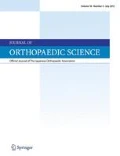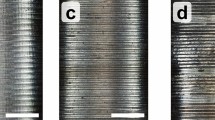Abstract
Background
In cemented total hip arthroplasty (THA), a polished tapered femoral stem with a design based on the taper-slip concept enables extremely reliable and durable fixation. In contrast, cemented femoral stems made from titanium alloys are not favored because of reports describing insufficient clinical outcomes. However, we have reported excellent clinical and radiological outcomes for cemented titanium stems made using the composite-beam concept. This study examines the characteristics of cemented titanium femoral stems with a smooth surface.
Methods
The bonding strength between titanium alloys with different surface finishes and bone cement was evaluated by use of push-out and detachment tests. Torsional stability tests were performed to evaluate the initiation and propagation of disruption of the fixation of cemented stems at the cement–implant interface. The wear resistance was investigated by use of wear–friction tests performed using a multidirectional pin-on-disc machine. The bone strain loaded on to the femoral cortex was measured by use of an implanted Sawbone and analyzed by use of the finite element method.
Results
The push-out and detachment tests revealed increasing cement adhesion strength with increasing degree of roughness of the metal surface. The torsional stability tests indicated that a load >1,000 N led to progressive debonding between the cement and the implant with a smooth surface finish. Interestingly, wear–friction tests revealed the wear rate for polished titanium surfaces was clearly higher than for smooth surfaces. In addition, the greater elasticity of titanium stems compared with cobalt–chromium stems transmitted the external load to the proximal side of the femur more effectively.
Conclusions
The smooth surface finish of the stems is an important factor for the satisfactory clinical and radiological outcomes of cemented titanium femoral stems. The greater elasticity of a titanium stem effectively transmits the external load to the medial side of the femur.







Similar content being viewed by others
References
Older J. Charnley low-friction arthroplasty: a worldwide retrospective review at 15 to 20 years. J Arthroplast. 2002;17:675–80.
Dall DM, Learmonth ID, Solomon MI, Miles AW, Davenport JM. Fracture and loosening of Charnley femoral stems. Comparison between first-generation and subsequent designs. J Bone Joint Surg Br. 1993;75:259–65.
Crowninshield RD, Brand RA, Johnston RC, Milroy JC. An analysis of femoral component stem design in total hip arthroplasty. J Bone Joint Surg Am. 1980;62:68–78.
Scheerlinck T, Casteleyn PP. The design features of cemented femoral hip implants. J Bone Joint Surg Br. 2006;88:1409–18.
Huiskes R, Verdonschot N, Nivbrant B. Migration, stem shape, and surface finish in cemented total hip arthroplasty. Clin Orthop Relat Res. 1998;355:103–12.
Shen G. Femoral stem fixation. An engineering interpretation of the long-term outcome of Charnley and Exeter stems. J Bone Joint Surg Br. 1998;80:754–6.
Berry DJ, Harmsen WS, Ilstrup DM. The natural history of debonding of the femoral component from the cement and its effect on long-term survival of Charnley total hip replacements. J Bone Joint Surg Am. 1998;80:715–21.
Crowninshield RD, Jennings JD, Laurent ML, Maloney WJ. Cemented femoral component surface finish mechanics. Clin Orthop Relat Res. 1998;355:90–102.
Hustosky KT, Norman TL, Kish VL, Blaha JD, Gruen TA. The effect of creep on cement hoop stresses and axial displacement of a cemented femoral hip prosthesis in vitro. Trans Orthop Res Soc. 1996;21:423.
Yoon Y, Oxland T, Hodgson A, Duncan C, Marsi B, Lee J. Structural behaviour of a bone-cement implant system under axial load: the effect of stem-cement bonding and geometrical factors. Trans Orthop Res Soc. 2001;26:1073.
Carrington NC, Sierra RJ, Gie GA, Hubble MJ, Timperley AJ, Howell JR. The Exeter Universal cemented femoral component at 15 to 17 years: an update on the first 325 hips. J Bone Joint Surg Br. 2009;91:730–7.
Sarmiento A, Gruen TA. Radiographic analysis of a low-modulus titanium-alloy femoral total hip component. Two to six-year follow-up. J Bone Joint Surg Am. 1985;67:48–56.
Hinrichs F, Kuhl M, Boudriot U, Griss P. A comparative clinical outcome evaluation of smooth (10–13 year results) versus rough surface finish (5–8 year results) in an otherwise identically designed cemented titanium alloy stem. Arch Orthop Trauma Surg. 2003;123:268–72.
Kovac S, Trebse R, Milosev I, Pavlovcic V, Pisot V. Long-term survival of a cemented titanium–aluminium–vanadium alloy straight-stem femoral component. J Bone Joint Surg Br. 2006;88:1567–73.
Akiyama H, Kawanabe K, Iida H, Haile P, Goto K, Nakamura T. Long-term results of cemented total hip arthroplasty in developmental dysplasia with acetabular bulk bone grafts after improving operative techniques. J Arthroplast. 2010;25:716–20.
Akiyama H, Kawanabe K, Yamamoto K, So K, Kuroda Y, Nakamura T. Clinical outcomes of cemented double-tapered titanium femoral stems: a minimum 5-year follow-up. J Orthop Sci. 2011;16:689–97.
Burstein AH, Wright TM, editors. Fundamentals of orthopaedic biomechanics. Baltimore: Williams & Wilkins; 1994.
Agins HJ, Alcock NW, Bansal M, Salvati EA, Wilson PD Jr, Pellicci PM, et al. Metallic wear in failed titanium-alloy total hip replacements. A histological and quantitative analysis. J Bone Joint Surg Am. 1988;70:347–56.
Witt JD, Swann M. Metal wear and tissue response in failed titanium alloy total hip replacements. J Bone Joint Surg Br. 1991;73:559–63.
Scholl E, Eggli S, Ganz R. Osteolysis in cemented titanium alloy hip prosthesis. J Arthroplast. 2000;15:570–5.
Willert HG, Broback LG, Buchhorn GH, Jensen PH, Koster G, Lang I, et al. Crevice corrosion of cemented titanium alloy stems in total hip replacements. Clin Orthop Relat Res. 1996:51–75.
Mann KA, Bartel DL, Wright TM, Ingraffea AR. Mechanical characteristics of the stem–cement interface. J Orthop Res. 1991;9:798–808.
Andriacchi TP, Galante JO, Belytschko TB, Hampton S. A stress analysis of the femoral stem in total hip prostheses. J Bone Joint Surg Am. 1976;58:618–24.
Bartel DL, Samehyeh E. The effect of cement modulus and thickness on stresses in bone-prosthesis system. Trans Orthop Res Soc. 1976;16:503.
McCarthy CK, Steinberg GG, Agren M, Leahey D, Wyman E, Baran DT. Quantifying bone loss from the proximal femur after total hip arthroplasty. J Bone Joint Surg Br. 1991;73:774–8.
Rohlmann A, Mossner U, Bergmann G, Hees G, Kolbel R. Effects of stem design and material properties on stresses in hip endoprostheses. J Biomed Eng. 1987;9:77–83.
Harrington MA Jr, O’Connor DO, Lozynsky AJ, Kovach I, Harris WH. Effects of femoral neck length, stem size, and body weight on strains in the proximal cement mantle. J Bone Joint Surg Am. 2002;84-A:573–9.
Lewis JL, Askew MJ, Wixson RL, Kramer GM, Tarr RR. The influence of prosthetic stem stiffness and of a calcar collar on stresses in the proximal end of the femur with a cemented femoral component. J Bone Joint Surg Am. 1984;66:280–6.
Conflict of interest
The authors declare that they have no conflict of interest.
Author information
Authors and Affiliations
Corresponding author
About this article
Cite this article
Akiyama, H., Yamamoto, K., Kaneuji, A. et al. In-vitro characteristics of cemented titanium femoral stems with a smooth surface finish. J Orthop Sci 18, 29–37 (2013). https://doi.org/10.1007/s00776-012-0298-5
Received:
Accepted:
Published:
Issue Date:
DOI: https://doi.org/10.1007/s00776-012-0298-5




